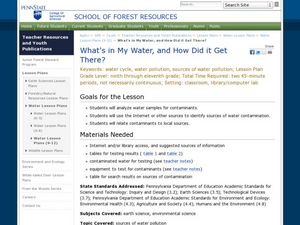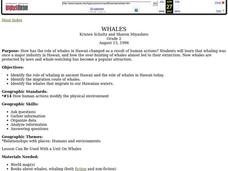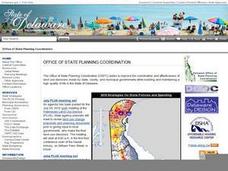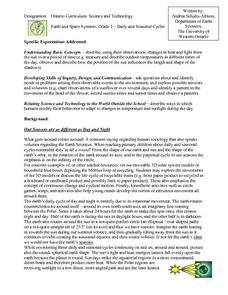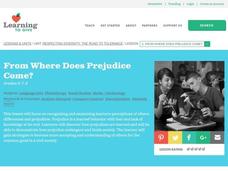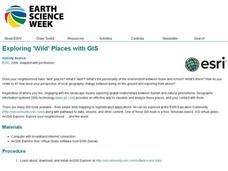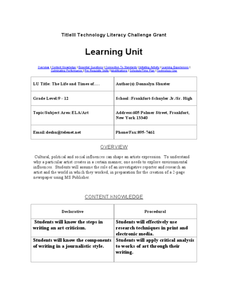Curated OER
D'Nile Is Where It's At!
Students travel down the Nile River to survey ancient Egypt in this unit of nine lessons. Data about pharaohs, hieroglyphics, growing crops, pyramids, the geography, and the sacred rituals are explored in this unit.
Curated OER
Sea Turtle Savvy
Students explore sea turtles. They create paper plate sea turtles and brainstorm other organisms that live in the sea turtle's habitat. They role-play scenes from a nonfiction book, A Baby Sea Turtle's Journey. They play a game...
Curated OER
Teaching the Five Themes of Geography Through Picture Books
Read the story Make Way for Ducklings and introduce little ones to the five themes of geography. Reread the story, while displaying transparencies to reinforce the five themes. In groups, learners view pictures and identify the themes on...
Curated OER
Scales, Scutes, and Skins
Students identify the various adaptations of reptiles and amphibians. After distinguishing between reptiles and amphibians, students discuss the ways in which their adaptations aid in their survival. They participate in a hands on...
Curated OER
Chemistry of Iron and Charcoal Manufacturing in PA
Students examine the historical purpose of the forests in Pennsylvania and investigate how the iron manufacturing process works. In this chemistry lesson students write the chemical formula for making charcoal.
Curated OER
What's in My Water, and How Did it Get There?
Students analyze water samples to see the contaminants and then use the Internet to find the sources of the contamination. In this investigative water lesson students analyze water and work together to solve the mystery of contaminants.
Curated OER
Mountain Myths
Students become familiar with Native American myths and legends created to explain volcanic activity. They apply the clustering, writing process and peer-editing techniques to the writing of an original myth about Mount St. Helens
Curated OER
Whales
Second graders identify the role of whaling in ancient Hawaii and the role of whales in Hawaii today, identify the migration route of whales and identify the whales that migrate to our Hawaiian waters.
Curated OER
Five Senses - Learning With The Senses
Students name the five senses, compare learning with and without the senses.
Curated OER
"Where in the World is my School?"
Students learn new vocabulary and discuss what GPS is and does. They locate their school using the equipment.
Curated OER
Cancer: A Crisis of the Cells
Pupils analyze cancer data represented in graphs and charts. They describe the changes in cell structure and function as the result of cancer. They also examine phenomenas that are believed to cause cancer.
Curated OER
N, B, and T: Pollutants Three
Students explore nutrient, bacterial, and toxic surface water pollution. They identify the amount of water they use each day and summarize the kinds of substances that cause water pollution. They predict what will happen in water...
Curated OER
Exploring Ecosystems
Fourth graders create an ecosystem as a class. They have already produced smaller ones. They use a pond or something similar on school grounds to meet the needs of certain plants and animals of their ecosystem. Specifically created will...
Curated OER
Science: Daily and Seasonal Cycles
First graders use their observations to describe daily and seasonal cycles. through a demonstration using a suspended ball and flashlight, they determine the time of day in various locations. Next, 1st graders participate in a...
Curated OER
The United Nations
Students are introduced to the role of the United Nations. Using the internet, they research its history and its influence on politics and peace. In groups, they create a timeline of significant United Nations conventions since World...
Curated OER
BATS: NEED NECTAR, WILL TRAVEL
Students play the role of nectar feeding bats on their annual migration
and try to avoid the different hazards that hinder their progress. They describe the annual migration of long-nosed bats including key elements such as: where the...
Curated OER
From Where Does Prejudice Come?
Students explore the concept of discrimination. In this social studies instructional activity, students view pictures and write down the first thing that comes to their mind. Students discuss if stereotyping or prejudice affected their...
Curated OER
Frog Olympics
Students explore the attributes of amphibians. In this physical frog biology lesson plan, students discover facts about the muscles of frogs and then play 2 games that require them to move like frogs.
Curated OER
Exploring 'Wild' Places With GIS
Students explore "wild" places. In this technology instructional activity students use ArcGIS Explorer to investigate wild places near them in their neighborhood. Students view the landscape from both above and the ground.
Curated OER
"In Like a Lion, Out Like a Lamb"
First graders listen to the story "Cloudy With A Chance of Meatballs" by Judi Barrett. They discuss weather forecasting and create an art project to go with the saying about March weather: "In Like a Lion, Out Like a Lamb".
Curated OER
The Life and Times of....
Students assume the role of an investigative reporter and research an artist and the world in which they worked. They create a 2-page newspaper using MS Publisher about the artist and the time period he/she lived in.
Curated OER
Fish Are Animals Too
Students create posters that show how a shark is a major predator in kelp forests and coral reefs after studying the food webs for these ecosystems. They determine that fish are important animals in the ocean's web of life.
Curated OER
Take Me Out Of The Box: Revealing Stereotypes
Students investigate the term "stereotype", explain how stereotypes can detract from a safe and caring community and disprove at least one stereotype. They also explore stereotypes, acknowledge their dangers and research ways to break...
Curated OER
What's In Your Grocery Bag?
Students explore the global implications of consumer decisions when purchasing groceries. They examine labels of food products and discuss the wording on the labels. They calculate food miles of how far each ingredient in foods has...







